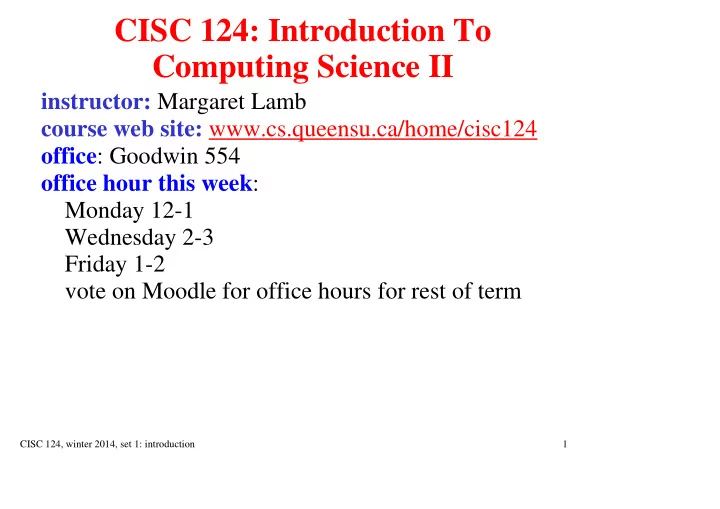

CISC 124: Introduction To Computing Science II instructor: Margaret Lamb course web site: www.cs.queensu.ca/home/cisc124 office : Goodwin 554 office hour this week : Monday 12-1 Wednesday 2-3 Friday 1-2 vote on Moodle for office hours for rest of term CISC 124, winter 2014, set 1: introduction 1
Moodle vs. Web Site Web site on CISC server: http://cs.queensu.ca/home/cisc124/ index_w14.html Option 1: • Read web site for basic information (content/admin) • Go to Moodle for extras (forums, etc.) Option 2: • Use Moodle as front page (links to everything in web page) CISC 124, winter 2014, set 1: introduction 2
Reading Assignment For Wednesday Read administrative info on web site. Pay special attention to syllabus & bring questions to class on Wednesday. Look at schedule, tell me about any problems with quiz dates CISC 124, winter 2014, set 1: introduction 3
Reading Assignment For Friday Chapters 1-3 of the Java text. See web site for sections you may skip. Complete Moodle survey about the reading by noon on Friday. I expect you to: • Do readings as assigned. • Complete surveys to tell me your reactions. CISC 124, winter 2014, set 1: introduction 4
Marking Scheme quizzes (best 3 of 4): 50% final exam: 34% assignments (best 7 of 8): 10% participation: 6% (questionnaires, forums, in-class activities) You must pass quizzes+final exam to pass the course. CISC 124, winter 2014, set 1: introduction 5
Academic Integrity • Everything you hand in must be your own work (assignments, quizzes, final) • Exception: may do assignments in group (2-4 students), all names must be on submission • Why? • It's only fair! • Queen's reputation, value of degrees CISC 124, winter 2014, set 1: introduction 6
What's This Course About? • Gaining more programming experience • Learning about Object-Oriented Programming (OOP) Language used: Java CISC 124, winter 2014, set 1: introduction 7
A Brief History of Java Predecessors: • CPL, BCPL (1960s) • B (1969) • C (early 1970s) • C++ (1980s, object-oriented) Java: • Sun Microsystems (now part of Oracle) • first public version 1995 • design team led by Jim Gosling (Canadian!) • initial target: embedded systems • goals included: portability & reliability • 1994: World Wide Web! CISC 124, winter 2014, set 1: introduction 8
Computer Languages & Translation Computers speak machine language – binary codes for very simple operations. Very cumbersome for humans to read and write! No standard: every make/model has its own language. Assembly Language: • Symbolic form of machine language • Easier for humans to handle • Simple program ("assembler") translates to machine language • Still involves a lot of detail • Still machine-dependent CISC 124, winter 2014, set 1: introduction 9
High-Level Languages Idea: Languages that are closer to the way we think: logic, data types, mathematical notation Advantages: • Easier/faster to read & write • Can be translated into different machine languages Disadvantages: • Needs a complicated translation program • Not always completely portable – depends on language design and translation programs CISC 124, winter 2014, set 1: introduction 10
Translation Methods • Interpreter (Python, Basic) • Compiler (C, C++) • Hybrid Approach (Java) CISC 124, winter 2014, set 1: introduction 11
Interpreter Reads & executes a program in a high-level language. • Read a line or statement • Figure out what it means • Make it happen • Repeat! Python Python output of Program Interpreter program input to program CISC 124, winter 2014, set 1: introduction 12
Compiler Reads a program in a high-level language. Creates an equivalent program in machine language. Step 1: machine C C language Program Compiler program Step 2: machine input to output of language program program program CISC 124, winter 2014, set 1: introduction 13
Pros & Cons Need For Extra Program: • Compiler: Program is compiled once. You don't need the compiler to run the program. • Interpreter: You need the interpreter each time you run the program. Efficiency: Interpreted languages traditionally viewed as less efficient. Changing with clever new technology ("just in time" compilation). Portability: • Compilers: You need to write a compiler for every "platform" (hardware & OS) • Interpreters: Not always necessary Both: Great care is needed to make a language truly portable (same results on all kinds of computers) CISC 124, winter 2014, set 1: introduction 14
Java's Hybrid Approach JVM = Java Virtual Machine A hypothetical computer "Bytecode": the machine language of the JVM. Designed to suit the Java language, still pretty low-level. Step 1: (once) Java Program Java bytecode program (.java) Compiler (.class) Step 2: (every time you run the program) bytecode program Java Program Output (.class) Interpreter Program Input CISC 124, winter 2014, set 1: introduction 15
Recommend
More recommend